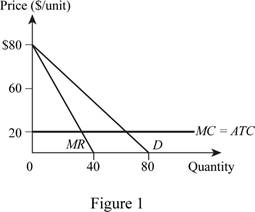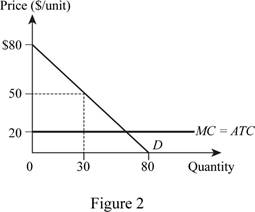
(a)
The competitive output and the price in the market.
(a)
Explanation of Solution
When the market is competitive, the price will be determined such that the marginal cost equals price. Here, the marginal cost is given to be $20, which means that the competitive price in the market will be $20. The output in the market can be calculated by substituting the price in the demand equation as follows:
Thus, the
Imperfect competition: Imperfect competition is the market structure where there are many sellers selling the differentiated products, and there will be information asymmetry in the market, which provides some market control to the producers.
(b)
The
(b)
Explanation of Solution
The marginal revenue of the firm can be derived as follows:
Thus, the marginal revenue curve will be
Thus, the marginal revenue curve can be illustrated as follows:

(i) The competitive output was 60 units, whereas the monopoly output is calculated to be just 30 units. Thus, the proportion of the two market condition outputs can be written as follows:
Thus, the proportion is
(ii) The monopoly price can be calculated by substituting the value of Q in the demand equation as follows:
Thus, the market situation can be illustrated as follows:

In Figure 2, the horizontal axis measures quantity, and the vertical axis measures price.
(c)
Output and price under the Cournot competition.
(c)
Explanation of Solution
Under the Cournot competition, there will be two players in the market producing the identical products. Thus, the inverse demand function of the market would be
Marginal revenue of firm 1 can be derived as follows:
Thus, the marginal revenues of the firm 1 is
Marginal revenue of firm 2 can be derived as follows:
Thus, the marginal revenue of the firm 2 is
Similarly, the reaction function of firm 2 can be calculated as follows:
The output of the firm 1 can be calculated by substituting the reaction function of 2 in the reaction function of 1 as follows:
Since both firms face the identical problem, both would produce 20 units each, and the total industrial output would become 40.
(i) The competitive output was 60 units, whereas the cournot output is calculated to be just 40 units. Thus, the proportion of the two market condition outputs can be written as follows:
Thus, the proportion is
(ii) The Cournot price can be calculated by substituting the value of Q in the demand equation as follows:
Thus, the market situation can be illustrated as follows:

In Figure 3, the horizontal axis measures quantity, and the vertical axis measures price.
(d)
Output and price under the 3 player Cournot competition.
(d)
Explanation of Solution
Under the three-player cournot competition, the inverse demand function of the market would be
Marginal revenue of firm 1 can be derived as follows:
Thus, the marginal revenues of the firm 1 is
Marginal revenue of firm 2 can be derived as follows.
Thus, the marginal revenue of the firm 2 is
Marginal revenue of firm 2 can be derived as follows:
Thus, the marginal revenue of the firm 2 is
All the firms face the marginal cost. The quantity of individual firs is equal
Similarly, the reaction function of other firms will be the same. Thus, each firm would produce 15 units each. Thus, the fraction of output would be equal to
(e)
Fraction of output when there are N firms in the market.
(e)
Explanation of Solution
When there are N identical firms in the market, then there will be N fractions produced in the market. Thus, the fraction of output brought to the market by each firm can be written as
(f)
Impact when there are N firms in the market.
(f)
Explanation of Solution
When there are N identical firms in the market, each firm would produce an identical output, which leads the market to converge into a competitive equilibrium. Thus, the price would also tend to move toward the competitive price in the market. Thus, the
Want to see more full solutions like this?
Chapter 11 Solutions
LaunchPad for Goolsbee's Microeconomics (Six Month Access)

 Principles of Economics (12th Edition)EconomicsISBN:9780134078779Author:Karl E. Case, Ray C. Fair, Sharon E. OsterPublisher:PEARSON
Principles of Economics (12th Edition)EconomicsISBN:9780134078779Author:Karl E. Case, Ray C. Fair, Sharon E. OsterPublisher:PEARSON Engineering Economy (17th Edition)EconomicsISBN:9780134870069Author:William G. Sullivan, Elin M. Wicks, C. Patrick KoellingPublisher:PEARSON
Engineering Economy (17th Edition)EconomicsISBN:9780134870069Author:William G. Sullivan, Elin M. Wicks, C. Patrick KoellingPublisher:PEARSON Principles of Economics (MindTap Course List)EconomicsISBN:9781305585126Author:N. Gregory MankiwPublisher:Cengage Learning
Principles of Economics (MindTap Course List)EconomicsISBN:9781305585126Author:N. Gregory MankiwPublisher:Cengage Learning Managerial Economics: A Problem Solving ApproachEconomicsISBN:9781337106665Author:Luke M. Froeb, Brian T. McCann, Michael R. Ward, Mike ShorPublisher:Cengage Learning
Managerial Economics: A Problem Solving ApproachEconomicsISBN:9781337106665Author:Luke M. Froeb, Brian T. McCann, Michael R. Ward, Mike ShorPublisher:Cengage Learning Managerial Economics & Business Strategy (Mcgraw-...EconomicsISBN:9781259290619Author:Michael Baye, Jeff PrincePublisher:McGraw-Hill Education
Managerial Economics & Business Strategy (Mcgraw-...EconomicsISBN:9781259290619Author:Michael Baye, Jeff PrincePublisher:McGraw-Hill Education





